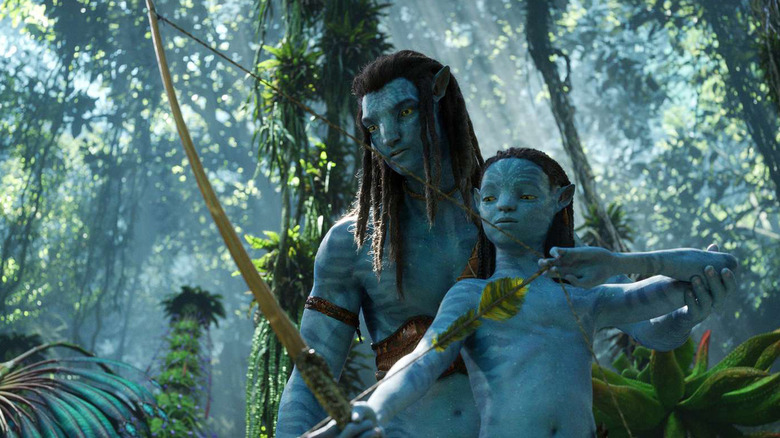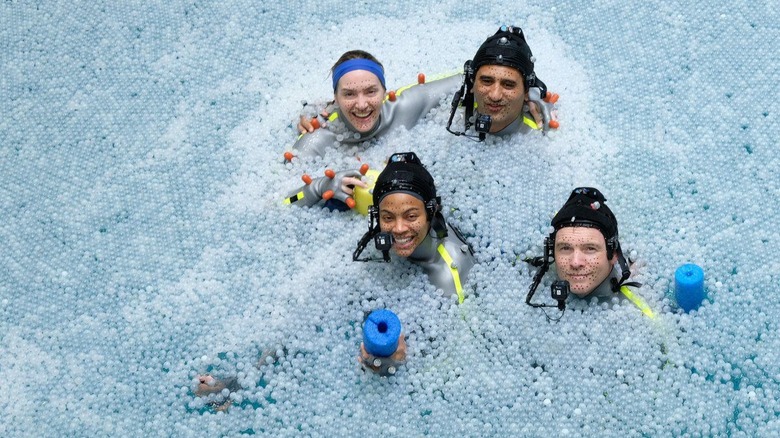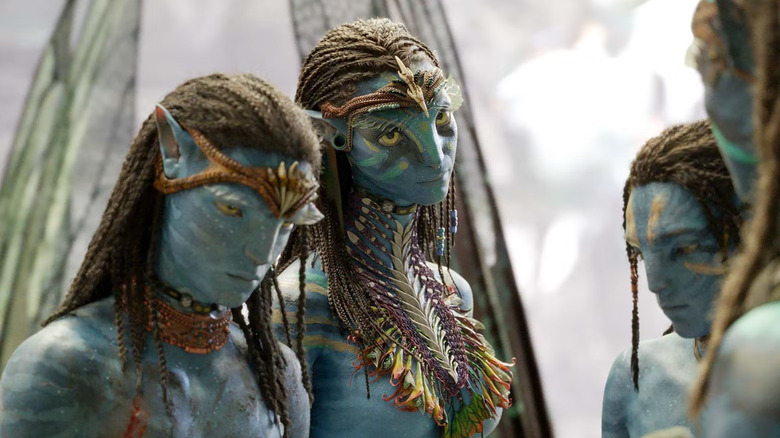Is Avatar: The Way Of Water An 'Animated Film'? Not If You Ask Its Editor
After a 13-year-long wait, "Avatar: The Way of Water" has been a triumph in every sense of the word. In addition to blowing past box office projections, "The Way of Water" has reasserted that James Cameron remains the king of the world making bigger and better blockbuster sequels. In our review, Chris Evangelista praised the movie's groundbreaking visuals and top-notch action sequences, arguing that it has a far more emotionally complex narrative than the first "Avatar" film. Of course, the internet is going to internet and there have been endless debates about the sanctity of "Avatar: The Way of Water" — specifically, whether it should really be classified as an animated movie, rather than a live-action one.
When the original "Avatar" came out, there was a clear sense that the film would revolutionize the way we see CGI-driven theatrical projects. The audience was more than ready to accept the existence of large, fictional blue creatures and connect with them on an emotional level. Over a decade later, the same remains true for "The Way of Water." The sequel has been nominated in a slew of Academy Award categories (including Best Picture), though not that of Best Animated Feature. Given that "The Way of Water" is mostly comprised of computer-generated imagery (CGI), however, some people feel it shouldn't qualify as a "non-animated" feature. If one were to ask the movie's editor, on the other hand, there's more to the matter than that.
'It is a live-action film'
In an interview with IndieWire, "Avatar: The Way of Water" editor Stephen Rivkin talked about the ongoing discussions surrounding animation and live-action. He argued that the films qualifies as live-action due to one key element — the actors' performances:
"Animation is something where they create characters and usually an actor comes in to replace an assistant's voice and create the character afterward. This is live-action filmmaking in the sense that it starts with the actor's performance and it ends up fully rendered with the actor's performance. When people say it's animated, it's not an animated film. It is a live-action film with real actors performing everything, and these actors did an amazing job."
A lot of blockbuster movies employ motion capture technologies to create fully-CG characters to varying degrees of success, but "The Way of Water" is a virtually seamless translation of real-life work. Every nuance of a cast member's facial expressions is captured, and the filmmaking behind the camera, such as blocking and camera movement, remains intact. The live-action or animation conversation will probably never end, but Rivkin raised an important point. And since he and James Cameron share the same sentiment, it's hard to argue against them. With that in mind, there's still room for a more nuanced conversation regarding what should truly qualify as "animation" in cinema.
A complex matter
To Stephen Rivkin point about "Avatar: The Way of Water," it is true that the motion capture aspect of the production separates it from the typical definition of animation. Historically, animation usually derives from the process of simulating movement using still hand-drawn images or non-living objects. Of course, most modern animation use CGI. Whether it is "Turning Red" or "Spider-Man: Into the Spider-Verse," even the most creative variations utilize digital imagery nowadays. Meanwhile, "Guillermo del Toro's Pinocchio" is a recent example of stop-motion, where real-life creations are brought to life via the rapid movement of frames. Unlike those projects, "The Way of Water" relies strictly on naturally occurring movement that has since been translated into CGI.
Does the conversation about animation stop there? Probably not. The use of hyperrealistic CGI without motion capture movement is still typically viewed as something other than animation. Jon Favreau's ventures into fidelity-focused work with "The Jungle Book" and "The Lion King" were famously omitted from the Best Animated Feature category at the Oscars. It seems that if a film looks realistic enough, it will be counted as live-action. But that justification is shaky compared to the argument posed by Rivkin in regard to the motion-captured performances in "The Way of Water," which adds a layer of validity to the claims that it isn't "animated." It's all pretty complicated, as one might imagine.
Semantics aside, Cameron's latest trip to Pandora feels pretty real if you ask me. "Avatar: The Way of Water" does not need to sell any more tickets to make a profit, but it's still in theaters if you want to revisit Pandora before the inevitable sequels arrive.


